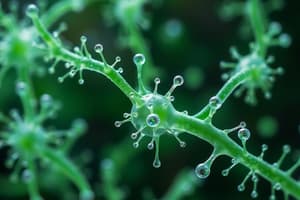Podcast
Questions and Answers
What is the scientific study of microscopic organisms and viruses called?
What is the scientific study of microscopic organisms and viruses called?
- Biology
- Microbiology (correct)
- Zoology
- Botany
Microorganisms can be found everywhere.
Microorganisms can be found everywhere.
True (A)
What is one beneficial role of microorganisms in agriculture?
What is one beneficial role of microorganisms in agriculture?
They help in soil nutrition.
The size of a typical bacterium is approximately _____ micrometers.
The size of a typical bacterium is approximately _____ micrometers.
Which of the following is a branch of microbiology focused on parasites?
Which of the following is a branch of microbiology focused on parasites?
What do we call the study of protozoans?
What do we call the study of protozoans?
Which domain of life includes bacteria?
Which domain of life includes bacteria?
What is the importance of microbial physiology?
What is the importance of microbial physiology?
What is microbiology?
What is microbiology?
Microorganisms are minute living things that individually are usually too small to be seen with the unaided ______.
Microorganisms are minute living things that individually are usually too small to be seen with the unaided ______.
Which of the following is a field of microbiology?
Which of the following is a field of microbiology?
Microorganisms are not found everywhere.
Microorganisms are not found everywhere.
What are prokaryotes?
What are prokaryotes?
Which of the following is NOT a branch of microbiology?
Which of the following is NOT a branch of microbiology?
What is the role of biotechnology in microbiology?
What is the role of biotechnology in microbiology?
What is one beneficial role of microorganisms in agriculture?
What is one beneficial role of microorganisms in agriculture?
Study Notes
Introduction to Microbiology
- The study of microorganisms and viruses, encompassing their roles in human disease, beneficial processes, and the environment.
- Microorganisms are minute living things, usually invisible to the naked eye, with a typical bacterium measuring 1 micrometer (µm).
- They are ubiquitous, meaning they are found everywhere.
Importance of Microbiology
- Number and reproduction: Microorganisms reproduce rapidly, making them easy to study and utilize in research.
- Biosphere Function: Microorganisms play crucial roles in the functioning of the biosphere, such as nitrogen fixation and nutrient cycling.
- Agriculture: Microorganisms are vital in agricultural practices, particularly soil health.
- Source of Nutrients: They contribute to the production of essential nutrients like vitamins B and A, as well as insulin.
- Modern Biotechnology: They are integral to modern biotechnology, particularly in genetic engineering.
- Harmful Impacts: Microorganisms can have detrimental effects on human health.
Fields and Occupations related to Microbiology
- Public Health Microbiology and Epidemiology: Focuses on monitoring and controlling the spread of diseases.
- Environmental Microbiology: Studies the relationships between microorganisms and their natural habitats.
- Biotechnology: Applies microorganisms for technological and industrial purposes.
- Immunology: Studies the immune system and its response to pathogens.
- Genetic Engineering and Recombinant DNA Technology: Utilizes microorganisms for manipulating genes.
- Agricultural Microbiology: Studies the roles of microorganisms in agriculture.
- Food Microbiology: Focuses on microorganisms' impact on food production and safety.
Branches of Microbiology
- Microbial Physiology: Studies the structures and functions of microorganisms, particularly their responses to the environment.
- Microbial Morphology: Investigates the shapes, sizes, and structures of microorganisms.
- Parasitology: Studies the biology of parasites and parasitic diseases.
- Protozoology: Focuses on the study of protozoans.
- Microbial Ecology: Examines the interactions between microorganisms, their environment, and other organisms.
- Molecular Biology: Studies the molecular mechanisms underlying biological activity.
- Phycology or Algology: Focuses on the study of algae.
- Microbial Taxonomy: Identifies and classifies microorganisms into known species and establishes new taxa.
- Bacteriology: Studies bacteria.
- Mycology: Studies fungi.
Origin of Microorganisms
- Prokaryotic: Microorganisms without a nucleus, their genetic material is scattered in the cytoplasm, particularly in the nucleoid region.
Introduction to Microbiology
- Microbiology is the scientific study of microscopic organisms, including bacteria, viruses, fungi, and protists, and their roles in various processes.
- Microorganisms are essential for life on Earth, playing crucial roles in the biosphere, human health, and various industries.
- The study of microbiology has a wide range of applications, including public health, environmental science, biotechnology, agriculture, and food production.
The Scope of Microbiology
- Microbiology encompasses a wide range of areas, such as:
- Microbial diversity and evolution: Understanding the origins and development of microorganisms.
- Microbial physiology: Analyzing the structure, function, and metabolism of microorganisms.
- Microbial genetics: Studying the genetic composition and inheritance of microorganisms.
- Microbial ecology: Investigating the interactions between microorganisms and their environment.
- Microbial pathogenesis: Understanding the mechanisms by which microorganisms cause diseases.
Naming and Classifying Microorganisms
- Microorganisms are classified using a hierarchical system based on their characteristics and evolutionary relationships.
- The three-domain system is the most widely accepted classification system, which categorizes all living organisms into three domains:
- Bacteria: Prokaryotic organisms, often unicellular.
- Archaea: Prokaryotic organisms often found in extreme environments.
- Eukarya: All organisms with a nucleus, including plants, animals, fungi, and protists.
A Brief History of Microbiology
- The study of microorganisms dates back centuries, with early observations made through microscopes.
- Anton van Leeuwenhoek (1632-1723) was a pioneer in microbiology, known for his detailed observations of bacteria and other microorganisms.
- Louis Pasteur (1822-1895) made significant contributions to microbiology, including disproving spontaneous generation and developing the pasteurization process for preserving food.
- Robert Koch (1843-1910) established the principles of Koch's postulates, which helped to identify the specific causes of bacterial diseases.
- The development of antibiotics in the 20th century revolutionized the treatment of infectious diseases, leading to a significant decline in mortality rates.
Importance of Microbiology
- Microorganisms are ubiquitous and play vital roles in various spheres.
- Environmental Significance:
- Decomposition: They break down organic matter, recycling nutrients in ecosystems.
- Nitrogen fixation: Certain bacteria convert atmospheric nitrogen into a form usable by plants.
- Biogeochemical cycles: Microorganisms contribute to the cycling of essential elements like carbon, nitrogen, and phosphorus.
- Human Health:
- Human microbiome: Billions of microorganisms inhabit our bodies, influencing our health and immunity.
- Pathogenesis: Microorganisms can cause diseases, ranging from mild infections to life-threatening illnesses.
- Biomedical applications: Microorganisms are used in the production of antibiotics, vaccines, and other pharmaceuticals.
- Industrial Applications:
- Food production: Microorganisms are involved in fermentation processes, producing yogurt, cheese, bread, and other food products.
- Biotechnology: Microorganisms are used in the production of various products, including enzymes, biofuels, and pharmaceuticals.
- Agriculture: Microorganisms contribute to soil fertility and plant growth.
Fields and Occupations in Microbiology
- Public Health Microbiology and Epidemiology: Monitoring and controlling the spread of infectious diseases.
- Environmental Microbiology: Studying the roles and interactions of microorganisms in the environment.
- Biotechnology: Applying microorganisms for producing various products, such as enzymes, biofuels, and pharmaceuticals.
- Immunology: Investigating the host's immune system and its response to microorganisms.
- Genetic Engineering and Recombinant DNA Technology: Modifying the genetic material of microorganisms for specific purposes.
- Agricultural Microbiology: Studying the interactions between microorganisms and agriculture, enhancing crop production and livestock health.
- Food Microbiology: Ensuring food safety and quality, controlling microbial contamination.
Branches of Microbiology
- Microbial Physiology: Focuses on the structure, function, and metabolism of microorganisms.
- Microbial Morphology: Studies the shapes, sizes, and structures of microorganisms.
- Parasitology: Concerned with the study of parasites and parasitic diseases.
- Protozoology: Investigates the biology of protozoa.
- Microbial Ecology: Studies the interactions between microorganisms and their environment.
- Molecular Biology: Explores the molecular basis of biological activity in microorganisms.
- Phycology or Algology: Studies algae.
- Microbial Taxonomy: Focuses on the classification, identification, and nomenclature of microorganisms.
- Bacteriology: Specializes in the study of bacteria.
- Mycology: Studies fungi.
Origin of Microorganisms
- Prokaryotes: These organisms lack a nucleus, and their genetic material (DNA) is scattered in the cytoplasm, specifically in the nucleoid region.
- Eukaryotes: Organisms with a true nucleus, where the genetic material is enclosed.
Studying That Suits You
Use AI to generate personalized quizzes and flashcards to suit your learning preferences.
Related Documents
Description
Explore the fascinating world of microorganisms and viruses through this introductory quiz on microbiology. Learn about their roles, reproduction, and importance in the biosphere, agriculture, and biotechnology. This quiz will enhance your understanding of these crucial life forms and their impact on the environment and human health.




